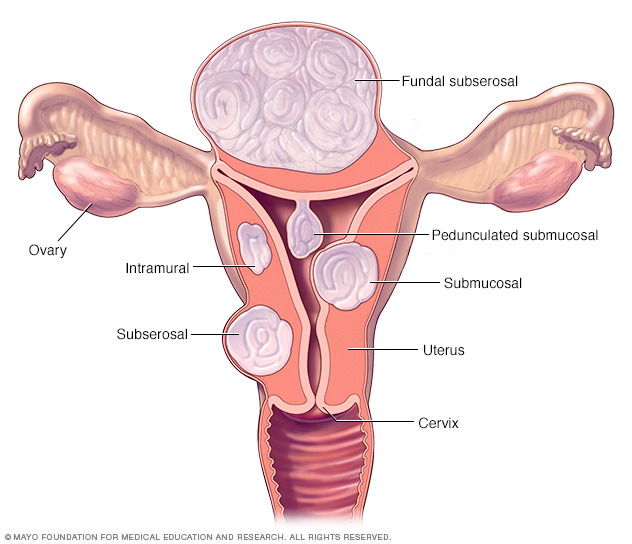Robotic myomectomy
![]() November, 20th, 2024
November, 20th, 2024
Summary
Learn about this minimally invasive procedure to remove uterine fibroids that may reduce pain, blood loss and recovery time.
Overview
, Overview, ,
Robotic myomectomy, a type of laparoscopic myomectomy, is a minimally invasive way for surgeons to remove uterine fibroids. With robotic myomectomy, you may experience less blood loss, fewer complications, a shorter hospital stay and a quicker return to activities than you would with open surgery.
Robotic surgery may take longer and cost more than traditional laparoscopy, but otherwise results are usually similar.

There are three major types of uterine fibroids. Intramural fibroids grow within the muscular uterine wall. Submucosal fibroids bulge into the uterine cavity. Subserosal fibroids project to the outside of the uterus. Some submucosal or subserosal fibroids may be pedunculated. This means they hang from a stalk inside or outside the uterus.
Fibroid locations Why it’s done
Your doctor may recommend robotic myomectomy if you have:
- Certain types of fibroids. Surgeons may use laparoscopic myomectomy, including robotic myomectomy, to remove fibroids that are within the uterine wall (intramural) or that project to the outside of the uterus (subserosal).
- Smaller fibroids or a limited number of fibroids. The small incisions used in robotic myomectomy make the procedure best for smaller uterine fibroids, which are easier to extract.
- Uterine fibroids that cause chronic pain or heavy bleeding. Robotic myomectomy may be a safe, effective way to get relief.
Risks
Robotic myomectomy has a low complication rate. Still, risks may include:
- Excessive blood loss. During robotic myomectomy, surgeons take extra steps to avoid excessive bleeding, including blocking flow from the uterine arteries and injecting medications around fibroids to cause blood vessels to clamp down.
- Infection. Though the risk is small, the robotic myomectomy procedure presents the risk of infection.
How you prepare
Food and medications
You’ll need to fast — stop eating or drinking anything — in the hours before your surgery. Follow the recommendations from your health care team on how long to fast.
If you regularly take medication, ask your care team if you should change your usual medication routine in the days before surgery. Also, tell your care team about any over-the-counter medications, vitamins or other dietary supplements that you take.
Other preparations
In most cases, robotic myomectomy is done as an outpatient procedure or requires one overnight hospital stay. Your facility may require that you have someone accompany you on the day of surgery. Make sure you have someone lined up to help with transportation and to be supportive.
What you can expect
Before the procedure
Robotic myomectomies are performed under general anesthesia, which means you’re asleep during the surgery. Ask your health care team about pain medication and how it will likely be given.
During the procedure
In robotic myomectomy, your surgeon makes several small cuts (incisions) in your belly to access and remove the fibroids. Sitting at a separate computer console, the surgeon uses special controls to operate a camera and surgical instruments attached to robotic arms. Some surgeons now perform single-port (one incision) robotic myomectomies.
Using smaller incisions means you may have less pain, lose less blood and return to usual activities more quickly than with other methods of myomectomy.
After the procedure
After a robotic myomectomy, you may stay in the hospital for one night. Your treatment team will observe your condition while you’re in the hospital, control your pain and make sure you’re comfortable. You can expect some vaginal bleeding for several days after the procedure.
During your recovery, which typically lasts about two to four weeks, you’ll need to avoid strenuous exercise and heavy lifting. Your doctor may encourage walking or other light exercise. You may return to work as soon as you feel able. You may resume sex as soon as you feel comfortable doing so.
Results
Outcomes from robotic myomectomy may include:
- Symptom relief. After robotic myomectomy surgery, most women experience relief of bothersome signs and symptoms, such as heavy menstrual bleeding and pelvic pain and pressure.
- Fertility improvement. Some studies suggest women have good pregnancy outcomes within about a year of surgery. After a robotic myomectomy, wait three to six months — or longer — before attempting to become pregnant to allow the uterus enough healing time.
© 1998-2025 Mayo Foundation for Medical Education and Research (MFMER). All rights reserved. Terms of Use



